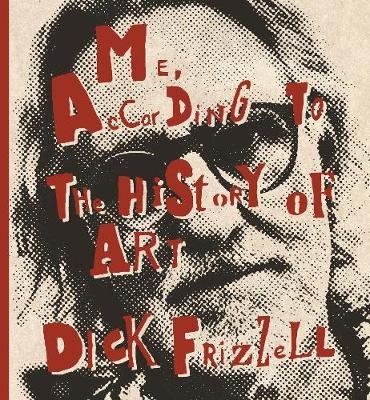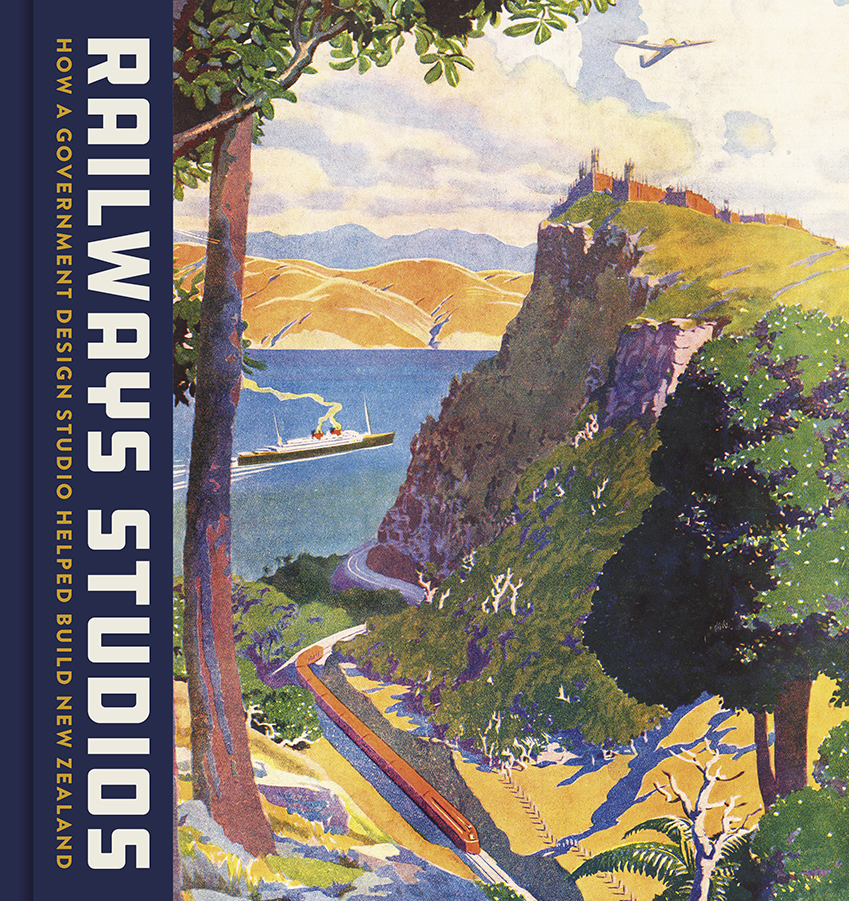
Massey
University and Te Papa Presses have published three gorgeous
new art books just in time for Xmas: Dick Frizzell's Me,
According to the History of Art, a quick art history
lesson from one of Aotearoa's most provocative artists;
The Railways Studios, celebrating unique examples of
government-sponsored advertising and design; and Nature -
Stilled, which features Jane Ussher's extraordinary
photographs of rarely displayed flora and fauna from the
museum's natural history collections.
Me, According
to the History of Art provides the kind of art history
education you never had, but wished you did, with painting
tips thrown in. Throughout his long career, Frizzell has
deliberately gone way out on a limb just to see where and
when it would break. From his early Pop art approach to his
experiments with landscape and the contested area of
appropriation, he has always been both courageous and
controversial. In this volume, Frizzell traces some key
threads in Western art, from paleolithic cave paintings all
the way through to abstraction, modernism, and
post-modernism. His apparently scattershot approach is pure
Frizzell - bring everyone along for the ride and make sure
you get them all smiling. His infective sense of humour -
the sustaining idea that art should be fun - is embedded in
a bedrock of serious scholarship and reverence for the
painters of the past. All the reproductions of significant
paintings, from Rubens and Tintoretto to Cezanne and
Lichtenstein, were completed by Frizzell himself.
Not
only does he track cave art through to today, but also has a
crack at recreating most of the book’s 125 paintings to
get an understanding how they have influenced him, his work,
and his approach to art as a twenty-first century painter.
In typical Frizzell style, it is a romping good read
interlaced with effervescent humour. But none of it is a
joke: he holds the painters of the past in high esteem and
reproducing the book’s selection of significant paintings,
not only provided him with greater insight into their work,
but was also a labour of love, completed over the period of
a year.
“My aim in writing this book - and painting
the reproductions of the works that appear in it - is to
clarify, demystify and deobfuscate this mad business of
smoke and mirrors we call art,” he says. “And I’m
going to tell that story against my background, which means
that it’s a very Eurocentric, Western story. Politically
or historically correct or not, this is the story I feel
behind me. It explains who I am as an artist. You could call
it The Anatomy of Dick. Because art history might be shit.
But the history of art isn’t. It’s the story of my life
- and yours.”
The book’s premise evolved as it
progressed - “It didn’t start out as an Art History
thing. I initially thought I could explain myself through
something as practical and pragmatic as the history of
paint. And then I started doing a bit of research ... I was
constantly conscious of balancing my frustration with
academic obfuscation with my respect for those very
disciplines. I think the thing that kept me level was the
fact that I knew I was writing from the point of view of the
painter, with the understanding that getting the stuff from
the palette to the painting hasn’t changed much in 32,020
years.”
Cubism is an important focus of the book -
“It’s what kicked off the whole book really. Going back
to my formative years at art school. Cubism was the first
‘concept’ I actually grasped. In a curious way the book
traces Cubist principles all the way back to the
Renaissance, where paintings began to be structured from
front to back as well as corner to corner. It’s the
over-arching structure of the entire narrative.”
A
helpful glossary of art terms is provided and a fascinating
coda, ‘Big Box Developments,’ in which Frizzell outlines
his thinking about the creative process, explains his grid
approach to painting, and shares other professional hints
and tips.
Me, According to the History of Art is an art history education that both art lovers and novices will enjoy. “I hope, vainglorious though it sounds, that “my” readers come away with an open and airy sense of the story of art, and how it is essentially an illustrated record of the evolution of our efforts to understand each other and our relationship with the world we live in,” Frizzell says. “The main problem and the most fabulous thing - is that the harder you try to demystify something like art, or philosophy, the more mysterious it gets. Creativity is really just the ability to see when a philosophical organising principle is past its use-by date and finding ways to refresh it. The idea that art helps us to keep ‘seeing’ the world anew (and hence continuing to value it) is probably my bottom line.”

On the centenary of its creation, Te Papa celebrates Railways Studios - the design studio of the New Zealand Railways - and its role in helping to construct, connect, and project an image of New Zealand through its niche market access to ad space. It is the story of a government agency that produced advertising for any-and-all clients, and dominated outdoor advertising from 1920-87. The Studios’ advertisements ranged from posters to painted billboards and brochures, and decorated every city and town, creating a broad variety of popular street art in public spaces for over sixty-five years.
Whatever the promotion - from rail travel and tourism to enlistment in the army, clothing and health promotion and the Studios played a role. Thousands of its designs influenced public attitude and shaped how Kiwis saw themselves. This definitive history of the art of Railways Studios opens up a cultural time capsule of life in New Zealand, detailing its formative place in national design and art history.
Such a volume required the collaboration of no less than four experts. Peter Alsop is a senior executive who has worked across the public and private sectors. He is a keen collector of New Zealand art, with particular interests in tourism publicity, hand-coloured photography and mid-century New Zealand landscape paintings. He is the author and co-author of nine previous books, including Promoting Prosperity, Hand-Coloured New Zealand and Scenic Playground.
Neill Atkinson is Chief Historian/Manager of Heritage Content at Manatū Taonga - Ministry for Culture and Heritage, where he is responsible for the Ministry’s history and reference websites: Te Ara - Encyclopedia of NZ, Dictionary of NZ Biography, Te Tai Treaty Settlement Stories, 28th Māori Battalion and NZ History. He is the author of six books and a number of articles and chapters, mostly on New Zealand political and transport history, including Crew Culture: New Zealand Seafarers under Sail and Steam, and Trainland: How Railways Made New Zealand.
Katherine Milburn is the ephemera collection curator at the Hocken Library, Dunedin, and has extensive knowledge of the Railways Studios’ output.
Richard Wolfe is an art, design and cultural historian who has a PhD in Art History from the University of Auckland and a BFA from the Elam School of Fine Arts. He was Curator of Display at Auckland War Memorial Museum from 1977 to 1997, and has written or co-authored around forty books covering aspects of New Zealand art, history and popular culture. He has contributed over fifty articles to the quarterly Art New Zealand, as well as articles to other journals, and has curated or supported the development of multiple art exhibitions.

Award-winning photographer Jane Ussher spent several weeks in Te Papa’s natural history collection storage areas shooting this outstanding book, and the result is an astonishingly beautiful volume of both great scientific and aesthetic interest. Stunningly photographed and beautifully designed, its 157 images capture the glory of the insect, fish, mollusc, and botanical specimens that represent Te Papa’s largely hidden natural history specimens.
Te Papa’s expert curators and collections managers have written brief texts about each natural history object, giving concise and unique insights into the fascinating characteristics of each of them. From photographs of huia and kākāpō to vivid x-rays of fish, gloriously coloured moths and butterflies, unique mosses, and lichens collected in Antarctica, this outstanding book pays tribute to both the btreath-taking beauty and incredible variety of the natural world.
On staff for the New Zealand Listener for many years, Usher has become one of New Zealand’s best-known photographers. She now has her own photography practice and regularly works for leading magazines and book publishers. Her many books include Coast: A New Zealand Journey (with Bruce Ansley), Worship: A History of New Zealand Church Design (with Bill McKay), The New Zealand Horse (with Deborah Coddington), Face to Face (with Paul Moon), Hillary’s Antarctica (with Nigel Watson), Islands: A New Zealand Journey (with Bruce Ansley) and Still Life: Inside the Antarctic Huts of Scott and Shackleton (with Nigel Watson).



 Tertiary Education Union: Weltec And Whitireia Cuts A Shocking Blow For Their Communities
Tertiary Education Union: Weltec And Whitireia Cuts A Shocking Blow For Their Communities PHARMAC: Pharmac Proposes To Fully Fund Nutrition Replacements For Some People With Crohn’s Disease
PHARMAC: Pharmac Proposes To Fully Fund Nutrition Replacements For Some People With Crohn’s Disease Nōku Te Ao: Bringing Together Voices On Mental Distress, Stigma And Discrimination Under One Roof
Nōku Te Ao: Bringing Together Voices On Mental Distress, Stigma And Discrimination Under One Roof Office of Early Childhood Education: Early Childhood Education Sector Confidence Survey Results 2025
Office of Early Childhood Education: Early Childhood Education Sector Confidence Survey Results 2025 Bikesport NZ: Intrepid Kiwi Teen Ready To Accept New Challenge
Bikesport NZ: Intrepid Kiwi Teen Ready To Accept New Challenge Wellington Access Radio: Young People Take Over Wellington Access Radio For Youth Broadcasting Week 2025
Wellington Access Radio: Young People Take Over Wellington Access Radio For Youth Broadcasting Week 2025